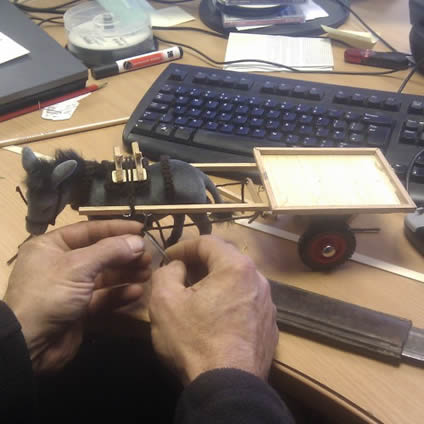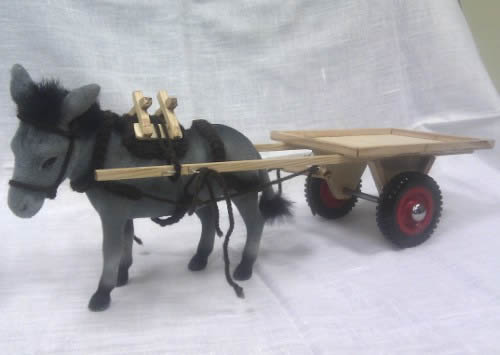
And photographs, if you have any.
Horseytalk.net Special Interview
Chris Garrett
WHY this little donkey is going to be my travelling companion all over the world for the foreseeable future.
Saddle maker, Chris Garrett, explains how lizzie will help him explain good harnessing techniques to people all over the world
Says Chris Garrett , The Donkey Sanctuary.
 Although I am a harness maker, I must confess that I am cheating! I can make a harness out of most things but knitting isn’t something I ever mastered. Thanks to Marian Gumbrell in our voluntary fundraising team for making up this beautiful set in her spare time.
Although I am a harness maker, I must confess that I am cheating! I can make a harness out of most things but knitting isn’t something I ever mastered. Thanks to Marian Gumbrell in our voluntary fundraising team for making up this beautiful set in her spare time.
Now, you might think that we at the Donkey Sanctuary we must be short of something to do if you look at the photo here. But this little donkey is going to be my travelling companion all over the world for the foreseeable future.
Why I hear you ask... Have you ever tried to teach a child how to tie a shoelace into a bow just by explaining the technique? It’s not a difficult thing to do but trying to put it into words seems to be incredibly complicated. Trying to explain how harness works is the same, only more so. It’s fine if you can go outside, find a donkey and cart that happens to be free for an hour or so, fit the harness, modify the cart and demonstrate the idea, but realistically when you are working overseas that takes a lot of setting up.
In my work as the Harness Advisor for the Sanctuary’s International Department I’m usually working with people who have no idea whatsoever about harnessing a donkey to a cart. At best they have something like the right equipment but have no idea how to fit it or how it works. At worst they have a loop tied to the front of the shafts that the donkey puts his head through, that’s it, just the loop which acts as both the pulling system, the brakes and carries the weight of the poorly balanced cart. On top of that they don’t usually speak English and translators don’t often come with harness experience, so often say something totally different to me.
Our work is changing as well. Following the success of the harness programme in many areas we are now being asked to go into universities to talk to trainee vets, government departments, schools, agricultural colleges, a lot of official training centres and governments are now realising that the way their people harness their donkeys literally is a life or death issue. Not just for the donkeys, many of these people would starve without this equestrian power house.
 (Don’t let anyone ever criticise you for worrying about donkeys when there are people suffering. Make no mistake, our work with the donkeys helps thousands of people survive every year).
(Don’t let anyone ever criticise you for worrying about donkeys when there are people suffering. Make no mistake, our work with the donkeys helps thousands of people survive every year).
These institutions however often ask us to give them a day’s training or less, that’s a very short time to pack in all there is to know about donkey welfare in general.
My little friend here, I think I might call her ‘Lizzie’, will, I hope, help me to show the principles of good harnessing in the classroom, we’ll still go out among the real donkeys don’t worry about that, it’ll just be much easier if the students have some idea of what we are trying to achieve before we get into all the distractions that a busy African town offers.
Judging by the reaction of my colleagues in the International Department I have a feeling that Lizzie may just take off, literally! Her offspring could soon be working all over the world helping people to see just why harnessing is so important, so, keep those knitting needles handy Marian!
Want to see how our work helps?
On one of my travels to a brick kiln site in Egypt we saw donkeys pulling well over a tonne of bricks in each load. We could hear them struggling for breath from more than 50 metres away, choked by the collars being pulled up toward the saddle. With the new system, the donkey in the this video was able to breathe easily and the saddle received no pressure, either in draught or braking.
Harnessing the Strain





